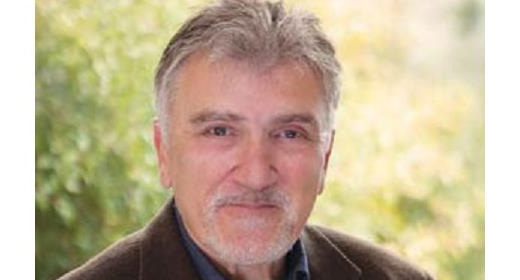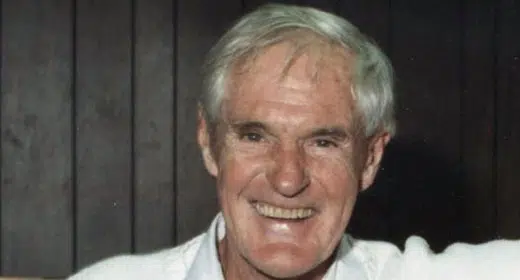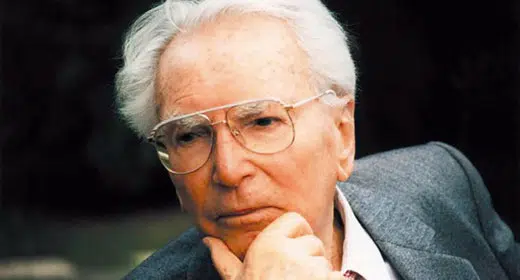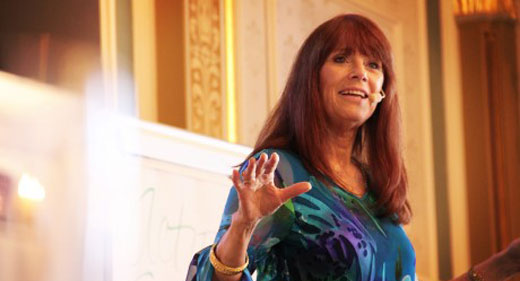Ex-hippie Gurmukh Kaur Khalsa is the teacher whom much of prenatal Hollywood has come to trust

by Gina Piccalo: A hush falls over the room, and all eyes turn to the petite woman in the white turban. On a small stage draped with red tapestries, Gurmukh Kaur Khalsa kneels before the class of about 50 women, all in different stages of pregnancy. Her expression is beatific as she speaks gently into her microphone headset. “Pregnancy is so pertinent, whether you’re pregnant or not,” she tells her students. “It’s about your own birth …. Everything becomes alive around pregnancy.”
The scent of lilies hovers over the class, whose members–many of them film producers, costume designers, hairstylists, models, actors and filmmakers–sit cross-legged on yoga mats spread over the wood floor.
Gurmukh, as she is known, is Hollywood’s favorite pregnancy guru. While Angelenos are infamous for idolizing their yoga instructors, this 60-year-old Kundalini yoga teacher has influence that has expanded beyond mere infatuation. She draws people by the thousands each month to her Golden Bridge yoga studio in Los Angeles, and she’s considered one of the nation’s yoga superstars.
Some of her appeal lies in her “mother knows best” approach to pregnancy and birthing, which encourages women to think for themselves rather than blindly follow the experts–herself included (though she’s influenced many of her students to attempt drug-free labors and at-home births). There is a touch of glamour to her flowing attire and metaphysical outlook, but Gurmukh up-close is earthy and approachable, speaking often of her “hippie days.” In fact, it’s her colorful past as a free-love flower child that captivates the “been there, done that” Hollywood crowd.
She also mines Hollywood’s ubiquitous celebrity factor with a roster of famous students–Madonna, Rosanna Arquette, Melissa Etheridge. A blurb from Cindy Crawford on the back of Gurmukh’s “The Eight Human Talents” (HarperCollins, 2000) reads: “I’m forever in her debt.”
And it doesn’t hurt business when Gurmukh’s name pops up in places such as this month’s W magazine, where Courtney Love, pulling up in a limo at the Viper Room with teacher in tow, is quoted as saying: “What she does is Kundalini yoga. It’s better for me than Prozac.”
Some people say that Gurmukh’s teachings on pregnancy and motherhood can be extreme. (She suggests that vaccinations and car seats are potentially harmful to infants, hospitals can be risky places to give birth and doctors only “catch” the baby during delivery.)
Others consider her a calm presence in the swirl of instruction available to pregnant women. “The best part about it is that you come here and you’re a goddess because you’re pregnant,” says Rebecca Bitton, a 30-year-old former actress who is six months’ pregnant with her second child. “For an hour and a half, you don’t feel like you’re in the chaos.”
During a recent class, Gurmukh’s students are attentive but relaxed, almost familial. Women laugh openly as their teacher describes her years traveling the country in a hippie caravan of school buses and working on an organic farm.
The conversation turns, and a student explains her tardiness. She was in a minor car accident. Gurmukh considers it a sign. “Maybe after this, you shouldn’t drive,” she says. “One thing you don’t want to do is try to be on time all the time. It’s better to go slow and be late. That’s why I never start this class on time.”
Indeed, 30 minutes pass before any yoga takes place. Gurmukh’s prenatal Kundalini classes often begin this way, with the teacher imparting her beliefs and offering an intuitive spin on developments in her students’ lives. She asks after specific women and sometimes offers a prayer for those nearing their due date or having troublesome pregnancies.
Then she leads a series of subtle movements that, when repeated for several minutes, become tests of will. This is the essence of Kundalini, movements paired with special breathing patterns, meditation and chanting that, according to its teachings, balance the energy centers of the body and harmonize a person physically, emotionally and spiritually.
Throughout, Gurmukh cheers them on. “Pull your baby’s home up,” she says instructing the women to lift their bellies as they sit cross-legged on the floor, rotating their bodies from head to waist. “Just let the body flow like an ocean wave! Feel your baby going for a great ride!”
Some women close their eyes and smile as they move, others keep their eyes open, looking exhausted and frustrated. Gurmukh continues her lesson, reminding her students that as pregnant women “we’re the strongest we’ve ever been.”
A camaraderie develops during the 90-minute classes, as students are encouraged to cast off inhibitions. Francey Grace, a 34-year-old film producer, found the class initially awkward and then liberating. “There is a sort of vibe that is interesting,” she says. “You’ve got, like, 40 pregnant women in the room. Everyone’s really content.” The cost: $15 a session.
Gurmukh insists that her role is to educate, not to advocate any one path. “I promote a woman to think for herself, to empower herself, because this soul has chosen her and is depending on her to know [what to do],” Gurmukh says. But she doesn’t hide her opinions, drawn from the Sikh religion and yoga, her guru and alternative publications.
Some of her students have opted not to vaccinate their babies or circumcise their sons because Gurmukh has warned them that vaccinations may be harmful to an infant and that circumcision is purely aesthetic and optional. “Doctors aren’t always right,” she says. “They’re not God.” After the birth, many of those mothers stay home for 40 days because Gurmukh stresses the need to bond with their child and allow themselves time to heal, a Sikh tradition.
But frequently students use what they want and ignore the rest. Grace tried to use the breathing and relaxation techniques she’d learned from Gurmukh to avoid pain medication during labor, but after the first five drug-free hours of a 15-hour labor, she opted for pharmaceutical relief.
As for the 40-day withdrawal after the birth, Grace confesses, “Staying in the house for 40 days would not be something I would be able to tolerate.”
Gurmukh’s views on Western medicine (she finds many aspects suspect) grew largely out of her own experiences as a pregnant 22-year-old. It was 1964, and she was then known as Mary Mae Gibson, fresh off her parents’ Illinois farm.
“The hospital delivery was horrific,” she says. “It was election night in November, and the doctors were watching the TV behind their backs as I was trying to deliver my baby ….They didn’t pay attention to me at all ….I was an afterthought.” The child was born with a congenital heart defect, and Gurmukh remembers bitterly that even as she struggled to cope with the news of her son’s condition, doctors were insisting that she have him circumcised. The baby died seven months later.
After her son’s death and a divorce from her first husband, Gurmukh spent six years wandering from Haight-Ashbury to Maui and Germany to Big Sur, where she lived in a tent and bartered for food with walnuts she found in the woods. “Of course, LSD came into it,” she says.
At one point she was addicted to diet pills and admits to having “excessive” numbers of sexual encounters. “I didn’t have a tomorrow in mind,” she says. “I just knew I had to do something to help the world.”
During a yoga workshop in Tucson in 1971, she met her guru, Yogi Bhajan, a Sikh man credited with introducing Kundalini yoga to America. He gave her the Sanskrit names Gurmukh, meaning “one who takes thousands across the world ocean,” Kaur meaning “princess” and Khalsa meaning “pure ones.
“You are to deliver babies,” the guru told her. So she befriended a Santa Fe, N.M., obstetrician and cleaned his house in exchange for birthing lessons. After a trip to India, Gurmukh says, “it came to me
In 1979, she moved to Los Angeles to open the city’s first Kundalini yoga center. There she met her second husband, Gurushabad. In 1984, they had a daughter at home, Wahe Guru, now 18.
Hollywood enters the biography in the early 1990s, when David Duchovny “discovered” Gurmukh–who teaches a range of yoga classes beyond the prenatal–bringing with him friends from the TV show “Twin Peaks,” including co-star Sherilyn Fenn.
While some of her teachings are considered radical, she finds support in the medical community. “Gurmukh is the real deal,” says Beverly Hills-based obstetrician Dr. Anthony Chin, who with his associate Dr. Paul Crane, recommends her prenatal classes to patients, particularly those interested in natural childbirth.
The breathing and meditation she teaches are “absolutely essential” for natural childbirth, said Dr. Chin. And less pain medication means a quicker recovery, he says. Though both doctors are “pro-vaccination,” they believe Gurmukh’s suggestions promote healthy skepticism and encourage women to do important independent research. “I think what she tries to teach is that there are a lot of reflex things we do that don’t necessarily need to be done,” Chin says. He sees her classes as a useful complement to birthing classes.
All practical guidance aside, Gurmukh says her goal is to help parents raise healthy, loving children so as to better our chances for global peace. “The nine months in the womb and the first three years of the child’s life makes them who they are in life,” she says. If children learn compassion and kindness, “that could change everything right there.”
Awaken Yoga
Awaken Spirit
Awaken Health & Wellness
Source: AWAKEN








































